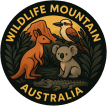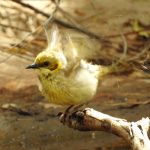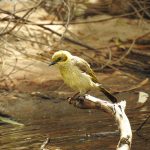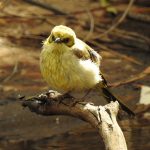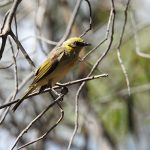YELLOW-TINTED HONEYEATER
Yellow-tinted Honeyeater
At first light on a tropical floodplain in Australia, a small olive-brown bird threads through paperbark blossoms, dusted in gold by pollen. Its voice rings with bright, tinkling notes as it sips nectar, then pauses to flick an insect from a leaf. This is the Yellow-tinted Honeyeater—subtle in colour, lively in spirit, and perfectly tuned to the rhythms of Australia’s northern savannas.
Identification: what to look and listen for
- Size and shape: A slender honeyeater about 15–17 cm long, with a fine, slightly down-curved black bill.
- Plumage: Olive-brown above, paler below with a soft yellow wash on the face and ear-coverts (the “yellow tint”). Wings may show a faint olive-yellow edge.
- Face detail: No bold stripes or white plumes; the face pattern is gentle, with the yellow centred around the ear area rather than forming a strong patch or plume.
- Eye and legs: Dark eye; greyish legs.
- In the field: Often active and social, moving through mid to upper foliage, especially around flowering eucalypts and paperbarks.
Voice
- Calls are light, musical and chiming—short, bright phrases and trills that carry in open woodland.
- Contact calls can be a clipped chitter; song becomes more varied where birds gather at rich nectar sources.
Distribution and habitat
- Range: Widespread across northern Australia—from the Kimberley (WA) across the Top End (NT) to the Gulf Country and Cape York Peninsula (QLD).
- Habitats:
- Open tropical savanna woodlands and riparian corridors
- Paperbark (Melaleuca) swamps and floodplain fringes
- Edges of mangroves and monsoon forests
- Town parks and gardens with suitable native flowering trees in the north
- Movements: Locally nomadic, tracking flowering eucalypts and paperbarks; numbers may swell at key nectar trees after rain or during peak bloom.
Diet and foraging
- Nectar specialists: Favour blossoms of Eucalyptus, Corymbia and Melaleuca. In the Top End, look for them in Darwin woollybutt (Eucalyptus miniata) and stringybarks (E. tetrodonta), or in broad-leaved paperbark (Melaleuca viridiflora).
- Insects: Glean small invertebrates from leaves and bark, and occasionally sally after flying insects—protein that’s especially important for growing chicks.
- Foraging style: Quick, purposeful movements through mid-canopy; often in small groups or loose mixed flocks with other honeyeaters.
Behaviour and social life
- Usually in pairs or small parties, with more birds gathering at abundant nectar.
- Mildly assertive around rich food; may chase smaller honeyeaters from a favoured tree.
- Keeps a busy rhythm—feed, call, preen, and move—especially active in the cool of morning and late afternoon.
Breeding
- Season: Mostly during the dry to early wet (roughly August to January), but flexible—timed to good flowering and insect supply.
- Nest: A neat, suspended cup of fine grass, bark strips and spider silk, placed in a shrub or tree fork, often 1–6 metres above ground.
- Clutch: Usually two eggs.
- Roles: Female incubates; both parents feed nestlings. Adults can be quite vigilant near the nest.
Similar species: quick field comparisons
- White-gaped Honeyeater (Stomiopera unicolor): Larger, with a strong white gape patch and louder, harsher calls; often in denser or riparian foliage.
- Yellow Honeyeater (Stomiopera flavus): Brighter overall lemon-yellow, mostly north-eastern Queensland; Yellow-tinted is more olive-brown with only a gentle yellow face wash.
- Brown Honeyeater (Lichmera indistincta): Slimmer with a longer, more curved bill and a pale gape line; lacks the concentrated yellow on the ear area.
- White-throated Honeyeater (Melithreptus albogularis): Contrasting black cap and clear white throat—quite different head pattern.
- White-plumed Honeyeater (Ptilotula penicillata): Prominent white “moustache” plume (not yellow); more widespread but typically in different inland and temperate habitats.
Conservation status
- Status: Least Concern (IUCN); not listed as threatened nationally.
- Local pressures:
- Clearing or degradation of riparian woodland and paperbark swamps
- Hot, frequent fires—exacerbated by invasive grasses—disrupting flowering cycles and habitat structure
- Climate change altering the timing and intensity of blooms and water availability
Subtle conservation message: safeguarding a mosaic of healthy savanna, riparian corridors and fire regimes that mimic natural patterns helps keep nectar, insects and nesting sites available—not just for Yellow-tinted Honeyeaters, but for a whole community of wildlife.
How to see them
- Best times: Early morning when eucalypts and paperbarks are in flower; listen for bright, tinkling calls.
- Where to look: Flowering trees along creeks, floodplain edges and woodland margins; scan mid to upper canopy.
- Optics and cues:
- Watch for small groups moving tree to tree.
- Note the gentle yellow ear wash rather than a bold face mark.
- Pay attention to which trees are flowering—honeyeaters follow the nectar.
Garden and community actions (Northern Australia)
- Plant local natives: Grevillea pteridifolia, Melaleuca (paperbarks and bottlebrush types), Eucalyptus miniata, E. tetrodonta, Banksia dentata.
- Provide layers: Shrubs beneath canopy trees create shelter and foraging structure.
- Water wisely: A clean birdbath in shade can help in the dry, refreshed regularly.
- Avoid feeding sugar: Natural nectar and insects are healthier.
- Support careful fire management: Community programs that reduce extreme fires protect flowering cycles and habitat.
Quick facts
- Scientific name: Ptilotula flavescens
- Family: Meliphagidae (Honeyeaters)
- Length: About 15–17 cm
- Diet: Nectar and small invertebrates
- Range: Northern Australia—Kimberley to Cape York
- Status: Least Concern
A final picture
Imagine a breeze carrying the honeyed scent of paperbark blossom and the dry-leaf rustle of savanna grasses. In that warm light, the Yellow-tinted Honeyeater stitches the canopy together with bright notes and busy flight. Protect the flowers, the waterlines and the gentle pattern of fire, and this small bird will continue to colour the north with its understated glow.
